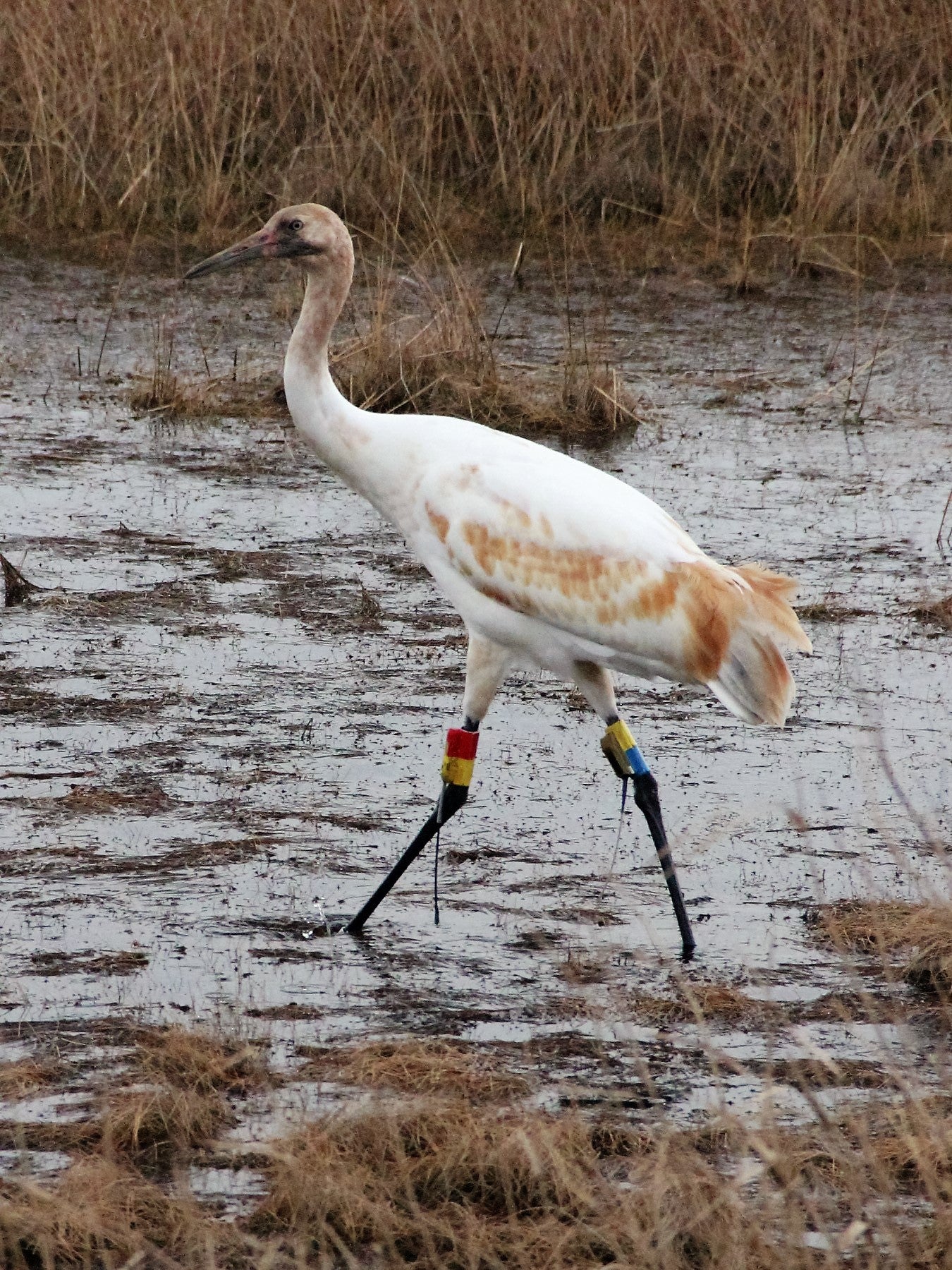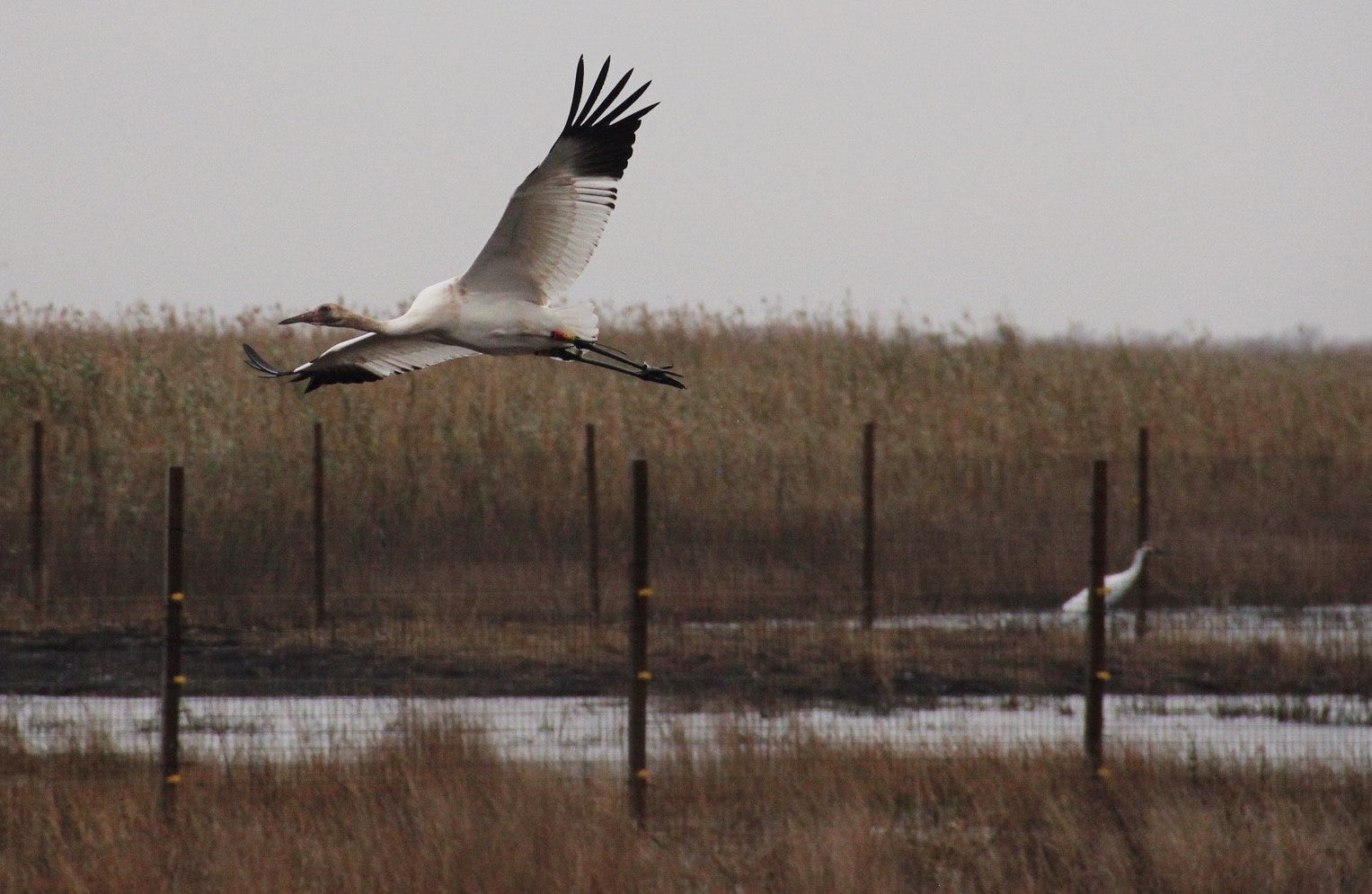Whoop Whoop for the Return of the Whoopers!
By Erik Johnson, Director of Bird Conservation & Karen Westphal, Coastal Project Manager, National Audubon Society
Originally posted on May 18, 2017 by Audubon Louisiana.
The tallest bird in North America nearly went extinct, and it is still teetering on the edge. Anyone who has seen a Great Egret knows the grandeur of such birds, but the Whooping Crane towers over the tallest herons and egrets, being 50% taller, and having a wingspan of 7.5 feet. Bright white, with a gallant red facial pattern, the magnificent Whooping Crane is being reintroduced into Louisiana, with the hopes of establishing a wild population that once again will thrive in our coastal and inland wetlands.

In 1941, an estimated 21 birds remained alive in the entire world, including six in Louisiana, which after that point never raised another chick in the wild. After a hurricane in 1940, the flock scattered, and a lost bird was captured and brought to the Audubon Zoo in New Orleans, where for many years she remained the only successfully breeding female in captivity.
By that time, the cranes’ preferred habitat had dramatically changed with human and natural alterations to the landscape. Wet prairies and wetlands had been converted into agriculture and pasture, which were less suitable to cranes. Further, this prized species was sometimes hunted (including illegally after the passage of the Lacey Act in 1905) for its meat but also for sport. To bag such a beast was considered an esteemed accomplishment. In March 1950, the last remaining Whooping Crane in Louisiana was captured and transported to the remnant Aransas National Wildlife Refuge flock in Texas.
Historically, Whooping Crane populations were either migratory or non-migratory, depending on the location. The migratory population that travels annually between Aransas NWR in the winter and Wood Buffalo National Park in Alberta, Canada, in the summer, is the most numerous and only remaining wild population, now totaling about 250 birds. The most famous reintroduction effort tried to mimic such a migration between Necedah National Wildlife Refuge in Wisconsin and Florida, teaching birds how to migrate with an ultra-light plane. This strategy has been marginally successful. Another reintroduction of a non-migratory population in Florida has resulted, unfortunately, with endlessly frustrating nesting failures. To ensure the establishment and self-sustainability of multiple populations is the ultimate goal of the Endangered Species Act, which protects this and other species on the brink of extinction. Expanding species recovery in new and promising landscapes is key.

In 2011, the Louisiana Department of Wildlife and Fisheries, after years of study, worked with the International Crane Foundation, U.S. Geological Survey, Louisiana Cooperative Fish and Wildlife Research Unit at LSU, and U.S. Fish and Wildlife Service to launch a plan to reintroduce a non-migratory population back into Louisiana. Louisiana’s rich coastal marshes and productive rice-crawfish agricultural areas were expected to be perfect to support these enormous (and constantly hungry) birds.
Each successive year, about 10-27 young cranes raised in captivity at Patuxent Wildlife Research Center near Washington, D.C., have been flown to Louisiana on a cargo plane. They are released into pens at White Lake Conservation Area, and now also Rockefeller Wildlife Refuge, where they are protected from predators, and fed, as the young cranes learn about their surroundings and begin finding their own food. After several weeks, the pens are opened, and the birds are free to move around the landscape. From there, they will take four years at a minimum before they begin breeding, which may take a few experimental years before they figure out the “trick” to hatching an egg and successfully raising a chick to adulthood.

One of the places where several Whooping Cranes have repeatedly found sanctuary, is at Audubon’s Paul J. Rainey Wildlife Sanctuary. Audubon’s oldest and largest wildlife sanctuary, Rainey is a truly wild place, with 26,000 acres of coastal marsh, no cars, and only one human, who fastidiously watches over and manages the property.
Rainey has been an important place for wild Whooping Cranes and in furthering the species as a whole. Eight cranes have spent time at Rainey. Last year, the first wild-hatched Whooping Crane in Louisiana since 1939 had a parent that spent two winters at Rainey (named L6-12). This year, of the nine pairs that attempted to nest, four had a partner that spent time at Rainey (L1-12, L6-12, L14-12, and L3-13.)

L6-12 pair produced the first chick last year and is still sitting on a second nest with one week to go. L14-12 and his mate L2-12 now have a chick labeled LW2-17, hatched in April 26.
The first chick of the year (LW1-17) was hatched from a fertile captive egg swapped in to non-Rainey parents, but disappeared after the recent severe rain and flooding event. Several of the nests have been abandoned after the same event, but apparently the pair that successfully hatched the first chick last year is still sitting eggs!

Today about 300 birds live in the wild, and approximately 300 birds are housed in captivity for a breeding program. Amazingly, extinction has been evaded, for now. Yet, the species is by no means secure and still faces a tremendous uphill battle to full recovery.